-
Posts
5,391 -
Joined
-
Last visited
-
Days Won
3
Content Type
Profiles
Forums
Blogs
Gallery
Events
Store
Posts posted by Gordon Williamson
-
-
Definitely not the normal Mayer tooling, or the pin/catch style normally found on Mayer badges.
On the E-Boat, the pieces made by Mayer have the flag solid with the deck of the boat, no gap like on this one. There are also some minor differences in the patterns on the wave under the bow of the boat. Could be wartime but definitely not made on the Mayer tooling..
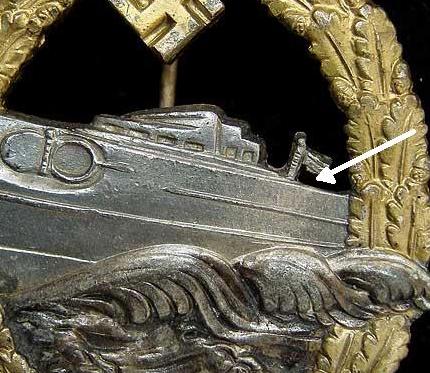
 0
0 -
This one could be OK but you'd need close up shots of the lettering like those posted by Alexey to be sure.
There are some perfectly good second pattern originals with that flat wire retaining clip instead of the more usual round wire version.
0 -
K&Q and W&L are very similar. The difference mainly lies in the eagles head and chest. If you look closely at the badges by the two makers you will see the difference.
0 -
Still looking for a verified Steinhauer U-Boat badge to add to a future revised edition of "Torpedo Los", also the "Beco" U-Boat Badge.
Grateful for input from anyone who may come across these.
0 -
It's an unmarked W?chtler & Lange. Quite a scarce maker to find.
0 -
Below are two badges, the first marked, the second unmarked. The reverse setups are different, but both appear to be Mayer?
Interesting if they are due to the reverse differences. John
Difficult to be certain that both are Mayer. As both Schickle and Mayer used the same basic badge with only the hardware differing, it would reasonable to say the one with the Mayer style hardware is propbably by that firm, but the other , with hardware that doesn't match Mayer or Schickle, could be either, though as its only the pin that differs, the hinge block and retaining clip being standard Mayer style, it is likely, that this one is by Mayer too. Its common enough for a single firm to have several pin fitting types on its badges.
0 -
Both Juncker and Steinhauer certainly produced 1914 Iron Crosses in the period between WW1 and WW2 and through until 1945.
0 -
Thanks Marc,
Glad you like it.
I couldn't even check re. your query as I don't have a copy myself yet, mine are still en route (one of the disadvantages of publisher and author being at opposite ends of the world).
0 -
For what it's worth I do actually happen to agree with a quite bit of Dietrich's theory of the S&L die tooling. I do tend to believe in the repaired die theory, and that flawed pieces can be genuine wartime examples.
My entry into this thread was because the 57 RK in question which was once mine was being repeatedly, categorically and totally wrongly identified as a second pattern 57 when it clearly wasn't.
Apparently I was also stated elsewhere as having claimed it was a so-called B-Type when I said no such thing. What I said was that it was unflawed, and of course that would have made it a so-called A-Type.
My point being that if totally unflawed frames survived the war to be used on 57 model Crosses (however few of these frames may have survived is unknown) then the unflawed aspect alone cannot be considered a 100% definite indicator of any 1939 type cross with swastika being of wartime manufacture.
0 -
It might just be cause you've got all the good'uns

Exactly !!! Chris there are probably several of us would very much like to buy some some but there is some bas***d over in Germany who seems to snaffle ever nice one that turns up.
0 -
I don't know why this 2nd pattern is so important to you and Gordon. It doesn't matter at all.
I should have thought that was rather obvious. You are the only one here who is saying that it IS a second pattern 57. You still haven't given any solid argument for that.
I would also have thought that the fact that flaws directly attributed by you to the so called "Type B" (flaws, dent rows) showing up what are claimed to be new postwar made dies might be worthy of comment. Certainly doesn't fit it with the "Type A" - "Type B" - New Postwar Dies theory.
Thanks for the link to the WAF thread but I have no interest in reading anything on that particular Forum.
0 -
I'd like to ask you this question again. What do you think?
Not very scientific to base opinions of originality soleley on markings (and nowhere near enough research has been done on the markings/stamps that S&L used) . Combined with other factors - ie. a 935 only mark ,a non ferrous centre,a flawed frame etc then I would avoid, but I don't think we are anywhere near to establishing that there is anything inherently wrong with 935-4, 800-4 or incuse 800.
0 -
It has been confirmed by somebody who has very detailled pictures of the cross in question that it is and always was a 2nd type 57 pattern.
Really !. Then it should pose no problem to post these detailed pictures here to prove your point.
Why the cross you show has some flaws is irrelevant for my purpose since it is clearly a 2nd pattern - also! I'm only interested in the evolution of the original die.Neatly avoiding the issue of why beading flaws and dent rows associated with wartime type frames would suddenly appear on so-called "2nd Pattern 57" frames.
0 -
Strange that it was agreed about needing magnification to see the flaws yet some people seem to be able to determine the 57 RK in question to be a second type 57 (which it is not) by eyesight from a low resolution scan.
How does one explain this one posted in the thread on 57 RKs by Naxos.
Flaws on lower arm, what looks suspiciously like a dent row, and a dipping eye
How does a newly cut "second 57 type" frame acquire a dent row and flawing ?

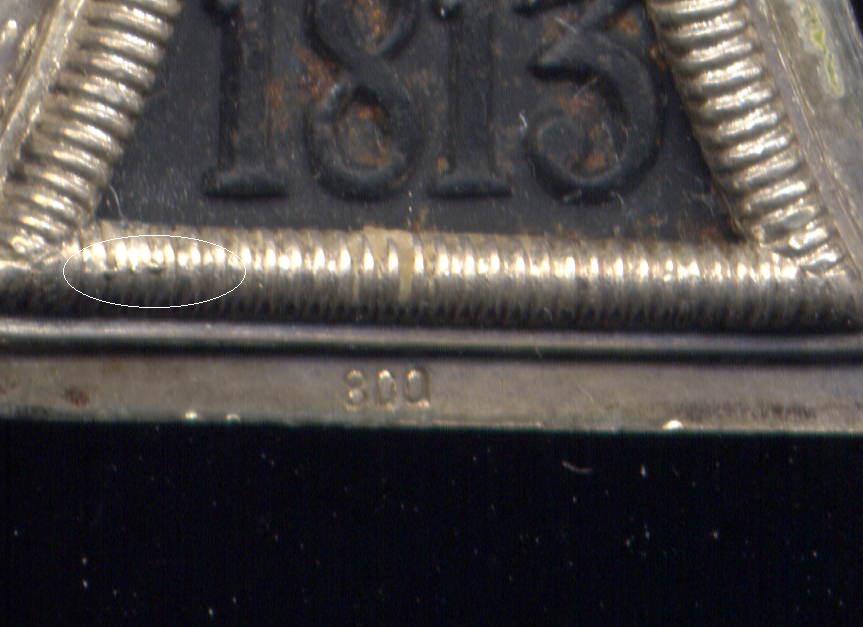

 0
0 -
Sadly, I doubt it would be easy to find any further info. Unlike U-Boats where a huge amount of work has been done in compiling databases of crew lists, I don't think anything of the kind exists for the Destroyers. Even organisations like Deutsche Dienststelle would be unlikely to come up with much with just a surname though its worth a try as its an unusual surname in a small branch of the armed forces.
0 -
Chris,
I agree with you completely. There was no "use-by" date associated with such metal components and it is perfectly possible that frame components stamped during wartime might have survived to be used in postwar products. I am sure that S&L went in for a lot of postwar assembly of wartime struck components as well as out and out post-war striking.
The inescapable flip side of that particular theory however (and all we have are theories, no established facts - which we will probably never know) is that if unflawed wartime struck frames were used in postwar 1957 pieces, then they may well also have been used in postwar assembled 1939 patterns with swastika, so the unflawed aspect could no longer give total assurance that a Steinhauer RK was original pre-May 1945.
I also find the debate over S&L markings rather interesting. Many of the markings found on S&L pieces have been considered dubious (incuse 800, 800 4 etc) with the argument that there was no reason for S&L to use such a wide range of marks. Given that during wartime S&L was one of the Reich's biggest producers of military decorations, and that after the war they predominantly only served the smaller collector market (as far as wartime decoratuions are concerned), why would they need to use such a wide range of stamps on postwar pieces, if these stamps were not already in existence ? Are we really expected to believe that they ordered up a new range of stamps just to be used on postwar strikings ?
0 -
David,
the 57 cross shown in post 22 is the second 57 model from S&L - the one with the dipping ring or ring into the frame. One cannot really compare the two crosses because the die is clearly different.
Dietrich
For the record, no, the Cross in question was NOT a second 57 model. I had several 57s at the time both early/late cores and early/late frames. The quality difference is marked between the two frame types in terms of the crispness of the striking and also the thickness of the cross section of the eye, the degree of burnishing etc etc. This one did not match any other second 57 model frame. To me having the advantage of examining the actual piece in hand as opposed to low res images, it was an early frame where the lower edge of the eye had not been removed by burnishing.
0 -
Very interesting entry. This was the Grossadmiral's personal guard battalion in the closing days of the war, and was commanded by U-Boat ace Peter "Ali"Cremer
0 -
As for the RK zum KVK, who can say? I have heard of examples bearing the "65" Lieferant code but cannot recall seeing one.
PK
One of the German dealers did have a 65 marked RK of the KVK a while back.
Entirely possible that Klein & Quenzer may have struck some samples for submission to the PK in the hope of gaining a contract but without a known, verified example of other manufacturers with good provenance, I'd treat any maker marked RK of the KVK other than Deschler, Zimmermann and Steinhauer with extreme caution.
Given the plethora of fake "thin" Deschler types around, I always found it amusing that "thick" RK of the KVK were instantly denounced as fakes. Probably because those doing the denouncing had only ever seen the "thick" postwar Souval pieces.
Perfectly genuine original Steinhauer pieces are much thicker than Deschler (though thinner than Souval's) something replicated in the superb wartime Steinhauer buttonhole miniatures which visibly taper from a thicker centre to a thinner section towards the tips of the arms.
Fortunately, the fakers have concentrated on Deschler ( probably because of the difficulty of getting their hands on a genuine Steinhauer or Zimmermann to copy - Zimmermann RK of the KVK are every bit as rare as their RK of the EK brethern). Much easier to pick up a genuine relatively common Deschler to copy.
0 -
Reverse details.
Anyone else have any others from these two series ?
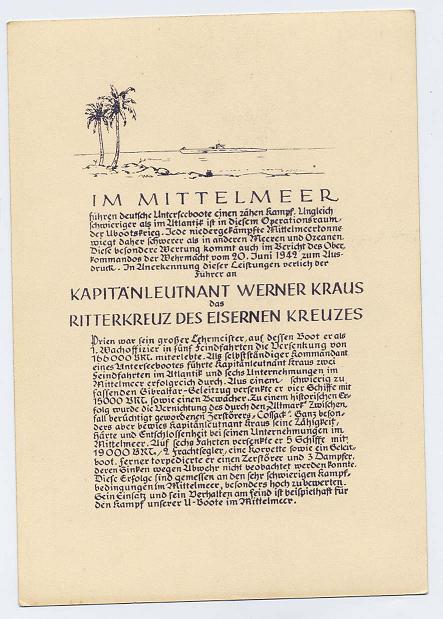

 0
0 -
Another series exists with much greater detail on the reverse. Unfortunately there are no printer/copyright details on the reverse to indicate who produced them.
Here is one of Werner Kraus. This is the same photo that Kraus would send out postwar.
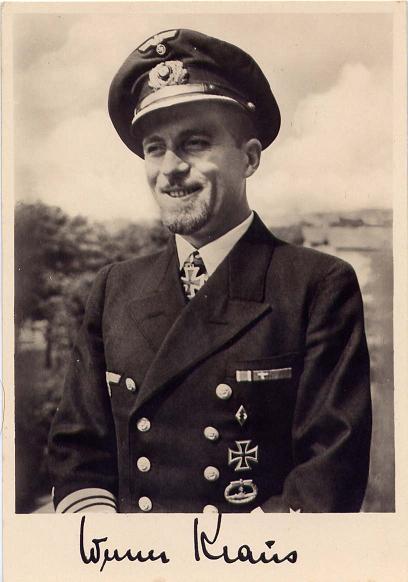

 0
0 -
These cards will all have the "Bildarchiv Krupp-Germaniawerft Kiel" logo at top left reverse and brief details of the individuals career at bottom left.
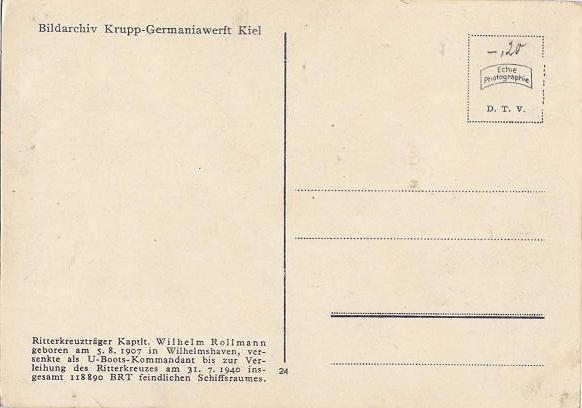

 0
0 -
-




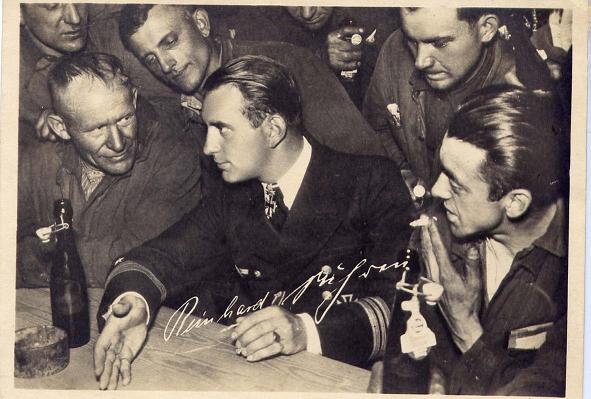

New U-Boat Book.
in Germany: Third Reich: Wehrmacht Medals, Decorations & Awards
Posted
Arthur Thornton of "World of Warfare" Books had some in stock but I don't know of he has any left. He has more on the way though.He had his shipped over by airmail.
If you want a copy with a personal dedication, I will have a (very) small supply of my own arriving shortly.